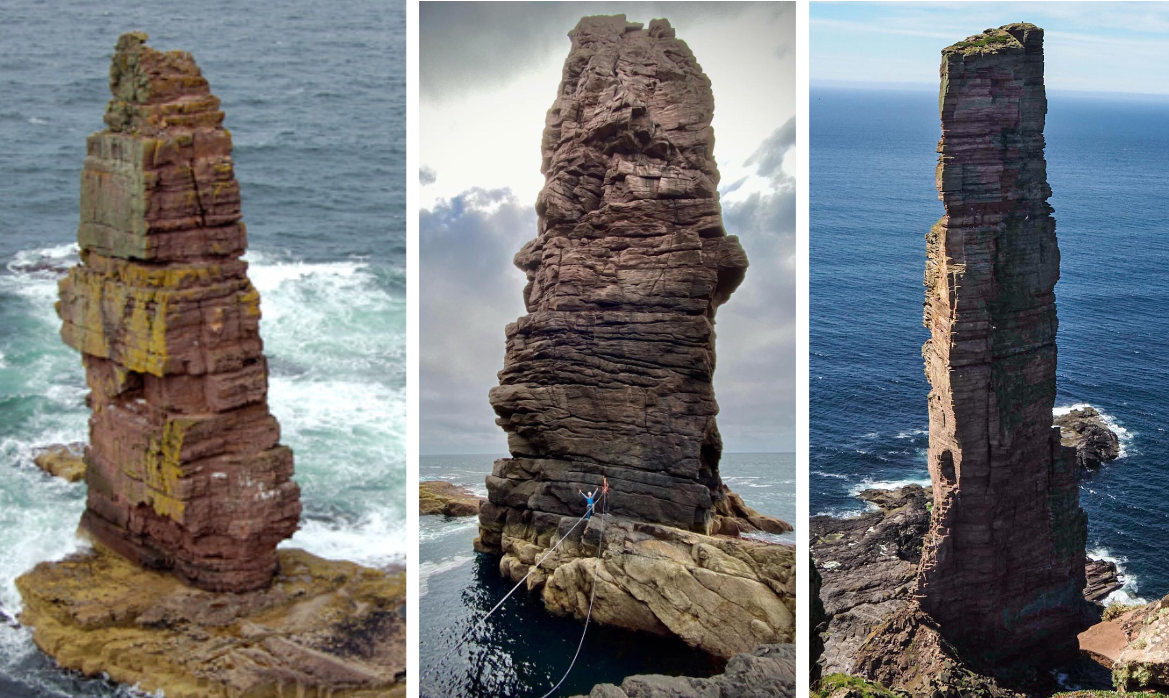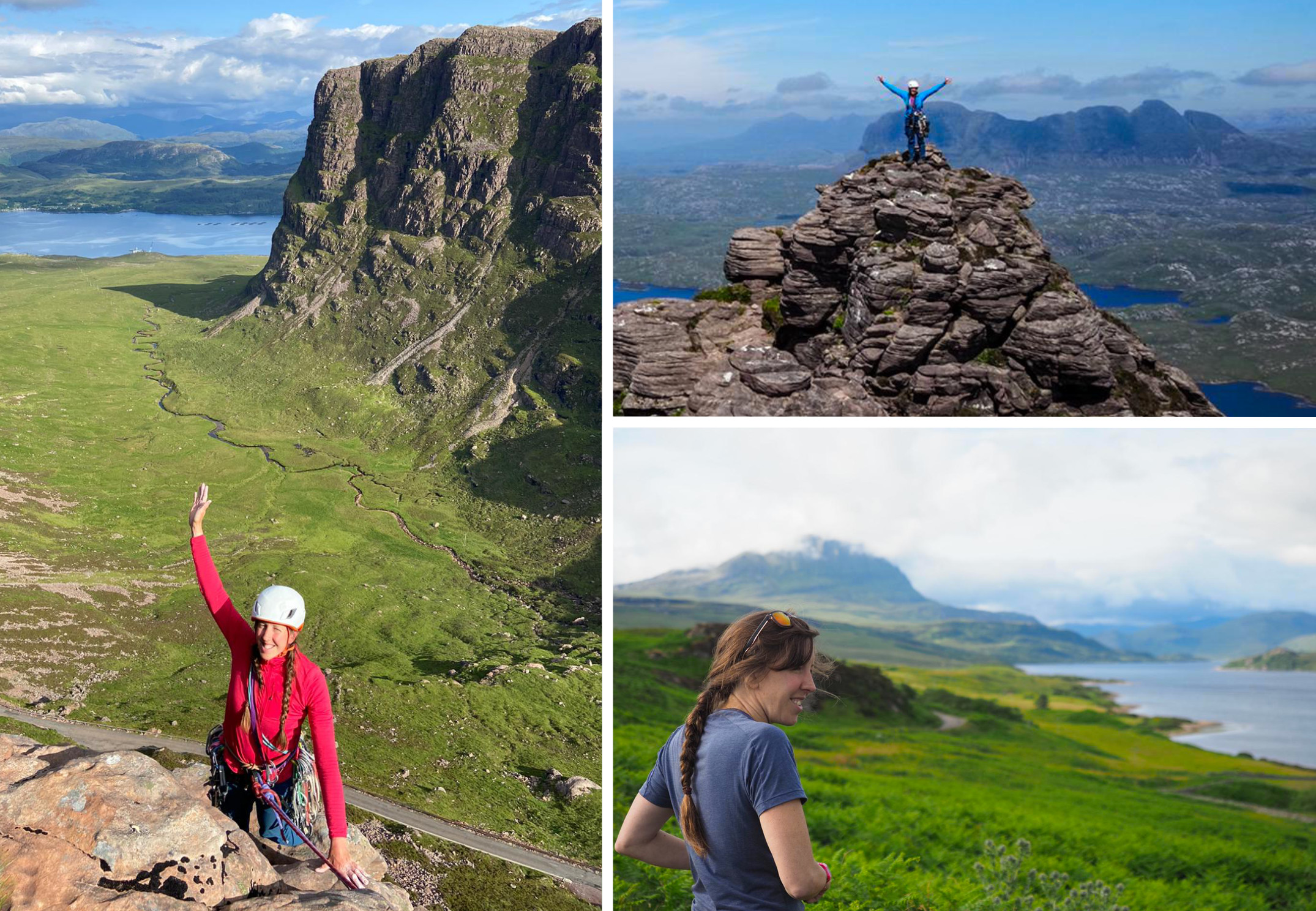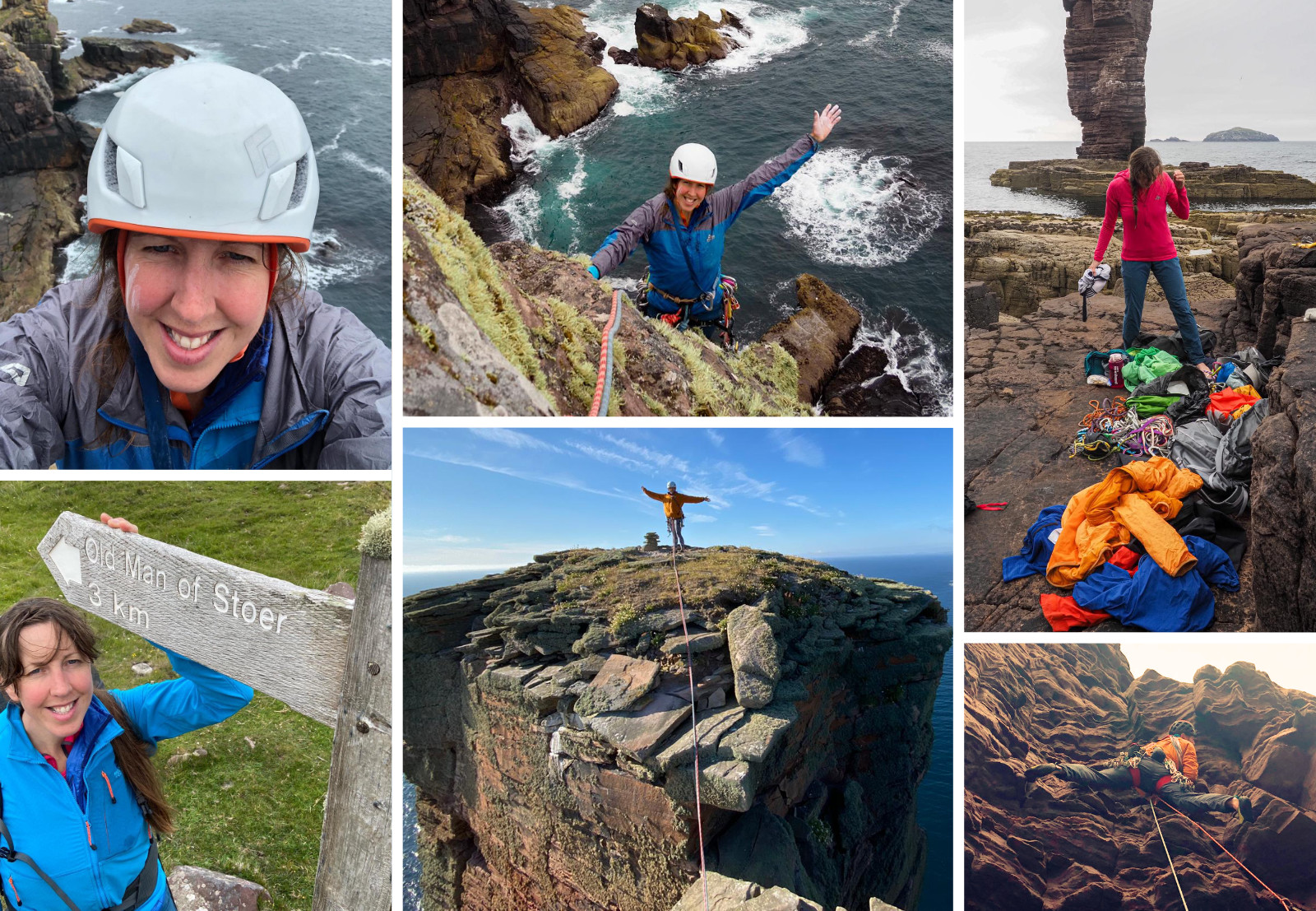SPONSORED CONTENT Emma Warren goes on a climbing road trip to Scotland, hoping to discover some of the finest adventure trad routes on the 'Three Old Men' Sea Stacks. When people ask what makes the UK a special rock climbing destination, the reply is usually 'adventurous trad routes.' And what's better - and stranger - than climbing sea stacks?! These towers make for exciting and often involved routes, with rough rock, poor weather and a risk of vomiting sea birds... it's the perfect test for Mountain Equipment's Women's Rock Climbing Collection...
Emma Warren goes on a climbing road trip to Scotland, hoping to discover some of the finest adventure trad routes on the 'Three Old Men' Sea Stacks. When people ask what makes the UK a special rock climbing destination, the reply is usually 'adventurous trad routes.' And what's better - and stranger - than climbing sea stacks?! These towers make for exciting and often involved routes, with rough rock, poor weather and a risk of vomiting sea birds... it's the perfect test for Mountain Equipment's Women's Rock Climbing Collection...
To have a good climbing trip in the Scottish Highlands requires the stars to align. You need good weather, dry rock and enough of a breeze to keep the midges away. Our plan was to climb the three most famous sea stacks in the UK, nicknamed 'The Old Men.' They are the Old Man of Storr, Hoy and Am Buachaille.

The Three Old Men
 If you haven't heard of midges, I can best describe them as incredibly irritating biting flies that can seriously ruin your day. They are about the size of a pinhead but often swarm in the hundreds if you stand still for long. The females are the biting ones and are attracted to carbon dioxide. So unless you’re superhuman and can hold your breath for a very long time, they will buzz around you, causing you to flap your arms about in wild abandonment (A midge net is vital in this situation) so you don’t want them for your climbing trip. They can send the most passive person mad!
If you haven't heard of midges, I can best describe them as incredibly irritating biting flies that can seriously ruin your day. They are about the size of a pinhead but often swarm in the hundreds if you stand still for long. The females are the biting ones and are attracted to carbon dioxide. So unless you’re superhuman and can hold your breath for a very long time, they will buzz around you, causing you to flap your arms about in wild abandonment (A midge net is vital in this situation) so you don’t want them for your climbing trip. They can send the most passive person mad!
Luckily for our planned road trip to Scotland, we’d been watching the weather forecast closely the week before our trip and deciding when to travel. We made the final decision to head north on the Friday, driving in our trusty camper the next day. We stopped in the beautiful city of Edinburgh to break up the journey and had some much needed family time.
Our rough objective of the holiday was to climb a sea stack. Neither of us had ever climbed one and after a year of Covid-19 we were keen to visit new places within the British Isles and have an adventure in beautiful places. Our first stop was just north of the fishing town of Ullapool on the north-west coat of Scotland.
Ardmair crag provides some fantastic climbing on Torridon sandstone. With a short walk to the base of the route it made a perfect start to our holiday. We climbed Shaker Loops and Gravity Rainbow, two fab E1s that swallowed cams on amazingly clean rock. I would soon be embracing the rounded sandstone climbing. It’s not my favourite type as I love edges and crimps and sandstone is basically the opposite.
Someone wise once told me “the only way to get better is to practice your weakness.” If you climb regularly on gritstone then I’m sure you will be well practiced at the art of this burly climbing. I, however, need to do a lot more - as it turns out!
Stac Pollaidh is a handsome-looking mountain, made up of rough grained pebbly Torridonian sandstone pillars and blocks perched high above Loch Lurgainn. It’s a fantastic rocky outcrop, left over from the last ice age, and creates a feature called a nunatak. From the rocky summit you are greeted by the most amazing views of the surrounding sea lochs and islands, a patchwork quilt of blues and greens.
It was one of those magical days where the air was crisp and you could see for miles. We climbed Jack the Ripper, a fine three pitch E1 with a great final pitch. Then for a more traditional climb we ascended November Grovers, a four pitch VS 4c requiring some hilarious bridging and grovelling up a rather steep grassy corner. I’m glad it was dry as the swearing might have got worse. The day was topped off by a swim in the Loch below to help us acclimatise for our next adventure.

The Old Man Of Storr is regarded as the finest of the classic three ‘old men’ . It didn’t disappoint - what an adventure. Just getting down to the base of the climb feels serious enough.
Due to it being my husband’s birthday I decided to do the swim. He said it was the best birthday present ever, watching me swim across the kelp-filled channel. I looked especially fetching in my stripy swimming costume and climbing helmet. ‘Remember danger never takes a day off” is my mantra. We were then able to set up the Tyrolean, which you tie into a spiders web of old pegs and rusty nuts lashed together by some new looking tat. Phew!
We decided to climb Diamond Face route, the E1 5b, to keep out the way of the majority of the nesting sea birds, mainly fulmars and oyster catchers. I decided to cover my lovely new Arrow jacket with my very old and trusty favourite Mountain Equipment windproof just incase we got splattered by the oily, fish-smelling bird puke. The climbing was steep and burly but was surprisingly clean and solid, unlike the next two sea stacks.
A narrow forecast of good weather for the Orkney Islands meant we hot footed it across to Thurso playing whacky races on the NC500 route. I lived in Applecross for a few years before this route was invented so I have been quite blown away by how busy the Highlands have got. We had to do a lot of heavy braking, smiling and waving, so mixed in with Covid-style greetings meant that we re-named the route ‘the 500 waves.’ Despite the slow journey we were treated to a stunning coastline and had to resist the temptation of stopping at every golden sandy beach along the way.
As you take the ferry across to Orkney you get treated to your first proper look at the Old Man of Hoy. He sits grandly looking out to sea, watching over the towering cliffs behind him, like a granddad watching over his children, proud and wise.
The descent down to the base isn’t half as harrowing as the Old Man of Storr. The climbing, however, is much more exciting and sandy. The steep second pitch is wild, with years of history still within its jaws. Old wooden wedges, rusty pitons and slings lead the way: adventurous climbing at its finest. Despite it being a glorious sunny day, we climbed in the shade and I was relieved to get to the top and warm up. We were treated to a stunning vantage point surrounded by the vast ocean and it felt even more special having it all to ourselves. I still can’t get my head around the fact that Jesse Dufton lead climbed it blind in 2019. An utterly courageous and epic achievement.
The final 60m abseil was definitely memorable, swinging out into space, and I slightly regretted that extra turn in my prussic. I was pumped by the time I got to the ground.
With some inclement weather we had a few days on Orkney, swimming in the sea, visiting standing stones and lots of old broughs. The history of the Islands is incredible, it’s well worth staying on for longer to tour around and make the most of it. We enjoyed listening to the England quarter-finals parked upon the north coast, seeing the neighbouring camper van shake every time we scored a goal.

The weather was looking ok back west again, so we decided to head back to the mainland, ticking off Ben Hope, the most Northerly Munro, on our way. We headed up the quieter NE ridge, paying our respects to the climbing legend Andy Nisbet and his climbing partner Steve Perry who were new routing on the mountain during the winter of 2019. It’s always sobering that someone so talented and experienced can still lose their life doing what they love.
Our final stack was Am Buachaille. I think with hindsight it was good to leave this one until last. The weather was far from perfect but with a worsening forecast we had to make the best of it. Both of us had to commit to the swim as there is no Tyrolean option. Matt had to put on his brave swim shorts, as despite his good swimming abilities he’s not so keen on getting wet. After a winter of swimming in Llyn Padarn, my local lake, I felt quite at ease with the water. Thank God, as it feels quite committing filling dry bags with all your racks and rope and dragging them across the channel.
The stack was really quite wet. Matt took the sharp end and got us to the top, despite the drizzle and dampness, climbing sustained HVS ground on ‘Original Routenot’. Be prepared for not particularly great gear and some big runouts on some rather sandy, breakable rock. We also somehow managed to avoid birds being sick on us, which was a miracle.
A rather damp walk back didn’t dampen the excitement of the day, topped off by listening to England win in the semi finals via the radio.
The final stop of the trip was the climbing the Cioch Nose which you can access from the famous Bealach na Ba (the nearest thing we have to a winding alpine road in the UK). It has scared the living daylights out of many an unsuspecting camper van driver.
Arriving in turbo drizzle, we decided to wait until the next morning. The forecast still didn’t look promising but we were treated to bright sunshine and a slight breeze. Sometimes you have to keep the faith.
It really did feel good to be back, descending down from the phone mast surrounded by imposing cliffs and with stags running around in the valley bottom. The route didn’t disappoint and provided us with some of the best rock we encountered all trip. It’s a fantastic route for the grade in a stunning position looking down to Loch Kishorn. We then headed down the road to climb The Sword of Gideon VS 4C, another classic route by Tom Patey who soloed it in 1961. The weather was so hot I had a massive nosebleed at the top. In fact the rivers are so low I struggled to find a pool large enough in the nearby river to have a wallow in to cool down. I never thought that would happen!
 When deciding what clothing to wear whilst climbing, we tried to pack light. I was really impressed by Mountain Equipment's women's range. The cut and fit of their clothing is impressive.
When deciding what clothing to wear whilst climbing, we tried to pack light. I was really impressed by Mountain Equipment's women's range. The cut and fit of their clothing is impressive.
- I normally struggle to get trousers to fit nicely, so I was really happy with the Dihedral women’s pant. They had a nice soft waist band with a draw cord for adjustment if you need it. Having hem ankle adjustments meant you could keep everything sung and out of the way when climbing. A handy leg pocket became useful for carrying my phone but didn’t impede movement.
- The Lumiko hooded women’s jacket is a super lightweight and stretchy fleece for climbing. It has a fab hood that doesn’t get blown off in the wind and fits really nicely under a helmet. Its neat cuffs and fit meant its become a daily favourite. I loved the colour, called Capsicum Red. It also also comes in blue green and inky blue type colours. The fabric is also 93% recycled materials which is impressive and definitely makes me feel better when buying new clothes.
- The Font women's hoody was super comfortable to climb in, wicked moisture away well on those hot sunny days and was a nice crag-to-pub type of top with a relaxed fit.
- The Arrow jacket provided me with some extra wind protection and warmth on those slightly chillier days. The harder-wearing material meant it could withstand climbing and mountaineering on longer mountain routes. Its slim fit and neat pockets definitely kept the bulk down and was used most days of our trip.
- Having a good t-shirt that wicks and looks nice is always a bonus. The Headpoint women's tee was really comfortable and quick drying on hot sweaty days. Yes, this is hard to imagine in Scotland, but it was uncharacteristically hot on our trip. I really liked the length, which meant it would sit nicely under my harness and it wouldn’t ride up when wearing a rucksack.

The items Emma used on her trip, from left to right - Dihedral Pant, Lumiko Jacket, Font Hoody, Arrow Jacket, Headpoint T
 Mountain Equipment have come up with a range of summer clothing that looks good but also fits really well. It has well thought-out and practical designs. They have great environmental credentials, having been awarded ‘Leader Status’ by Fair Wear Foundation in 2016, and have been awarded their highest accolade for performance every year since. Together with the Fair Wear Foundation (FWF), Mountain Equipment are working to achieve fair working conditions worldwide which is great to hear, and something they don’t promote enough. On our road trip to Scotland, we were lucky with the weather, which allowed us to have a fab adventure climbing in our lovely new clothing. Mountain Equipment came up trumps!
Mountain Equipment have come up with a range of summer clothing that looks good but also fits really well. It has well thought-out and practical designs. They have great environmental credentials, having been awarded ‘Leader Status’ by Fair Wear Foundation in 2016, and have been awarded their highest accolade for performance every year since. Together with the Fair Wear Foundation (FWF), Mountain Equipment are working to achieve fair working conditions worldwide which is great to hear, and something they don’t promote enough. On our road trip to Scotland, we were lucky with the weather, which allowed us to have a fab adventure climbing in our lovely new clothing. Mountain Equipment came up trumps!
Emma Warren is a Mountaineering and climbing instructor based in Wales. At the age of 18 Emma crossed the Silk Route on a climbing expedition travelling from London to Hong Kong. By the time she was 25, she had led a bunch of climbers from South Africa overland to Jordan. She has guided expeditions all over the world. And in her words “It’s been brilliant!”
You can follow Emma on Instagram or watch her YouTube interview.




